Why AI-Enabled PIM Is the Key to Reducing Product Returns in Online Retail
Introduction: The Rising Cost of Product Returns in E-Commerce
Product returns have become one of the biggest pain points for online retailers. In the USA alone, retailers lost over $743 billion in 2023 due to returns, according to the National Retail Federation (NRF). With e-commerce sales continuing to grow in 2025, experts predict that return rates could climb even higher — creating serious challenges for profitability, customer trust, and long-term loyalty.
But what’s causing this surge in returns? Often, it’s inaccurate product data, misleading descriptions, or poor-quality images that leave customers disappointed when their purchase doesn’t match expectations. This is where AI-enabled Product Information Management (PIM) systems are transforming the game.
Unlike traditional PIM tools, AI-powered solutions don’t just centralize product information; they analyze, enrich, and optimize product data in real-time. The result? Fewer mismatched orders, fewer customer complaints, and significantly reduced return rates for e-commerce businesses.
In this blog, we’ll break down:
The common issues leading to high return rates in online retail
How AI-enabled PIM systems solve these challenges
Real-world examples of reducing product returns with AI-powered PIM
Why investing in the right PIM solution can improve customer satisfaction, retention, and profitability
By the end, you’ll see why AI-enabled PIM is no longer just an optional tool but a necessity for modern online retailers in the USA market.

The Hidden Impact of Product Returns on Online Retailers
While product returns may feel like just another business expense, the truth is they carry hidden costs that directly affect profitability. Let’s break it down in simple terms.
1. Direct Financial Losses
Every return means not just losing the sale but also spending more money on:
Processing and logistics costs
Restocking or repackaging
Customer service handling
Potential product write-offs if the item can’t be resold
According to Statista, the average cost of processing an online return in the USA is around $27 per item, not including lost customer lifetime value. For retailers with thousands of returns monthly, this adds up to millions in losses annually.
2. Impact on Customer Trust & Loyalty
Nothing frustrates online shoppers more than receiving a product that doesn’t match the description or images. A single bad experience can lead to:
Negative reviews and ratings
Reduced repeat purchase intent
Lost trust in the brand’s authenticity
Research from PwC shows that 32% of customers will stop buying from a brand after just one bad experience. That means every return isn’t just a lost sale — it’s potentially a lost customer.
3. Environmental & Operational Costs
Returns aren’t just bad for profits; they’re also bad for the planet. Reverse logistics involves transportation, packaging, and disposal of returned goods, which contributes to carbon emissions. With sustainability becoming a core value for modern shoppers, high return rates can hurt both a retailer’s image and ESG commitments.
Why AI-Enabled PIM Matters Here
By ensuring that product data is accurate, consistent, and enriched with AI insights, businesses can prevent misinformed purchases before they happen. Fewer mismatches mean fewer returns, higher customer satisfaction, and stronger brand loyalty.

Common Issues Leading to Product Returns in E-Commerce
Despite major advancements in digital retail, many online stores still struggle with data-driven issues that lead to unnecessary returns. Let’s look at the most common ones.
1. Inaccurate or Inconsistent Product Data
One of the biggest reasons for returns is incorrect product descriptions. Imagine buying a shirt that’s listed as cotton but turns out to be polyester. Or ordering a gadget that’s advertised as compatible with your device — but isn’t.
Inconsistent product data across marketplaces like Amazon, Walmart, and Shopify stores creates confusion and frustration for buyers.
2. Poor-Quality or Misleading Product Images
Customers rely heavily on visuals when shopping online. If images are low-resolution, poorly lit, or don’t represent the product correctly, the risk of disappointment skyrockets.
In fact, a Shopify study found that 75% of online shoppers rely on product photos when making purchase decisions. If the real product looks different, it’s almost guaranteed to come back.
3. Missing Key Attributes & Specifications
Details matter. Missing product specifications like size charts, material information, technical compatibility, or warranty details can leave customers unsure. When in doubt, they either abandon the purchase — or buy and return it later.
4. Mismatched Customer Expectations
Sometimes the product is fine — but the way it’s presented online creates unrealistic expectations. Overhyped descriptions or vague details can cause customers to feel misled, driving them to return the product.
5. Lack of Personalization in Recommendations
Returns also spike when customers are shown products that don’t actually match their needs or preferences. Generic recommendations increase the chances of buyers choosing the wrong size, model, or variant.
This is where AI-enabled PIM systems step in — they ensure that product data is not just accurate but also enriched with AI insights, creating personalized and reliable shopping experiences.
How AI-Enabled PIM Reduces Product Returns
Now that we’ve seen the main issues behind product returns, let’s explore how AI-enabled PIM systems reduce return rates in e-commerce retail.
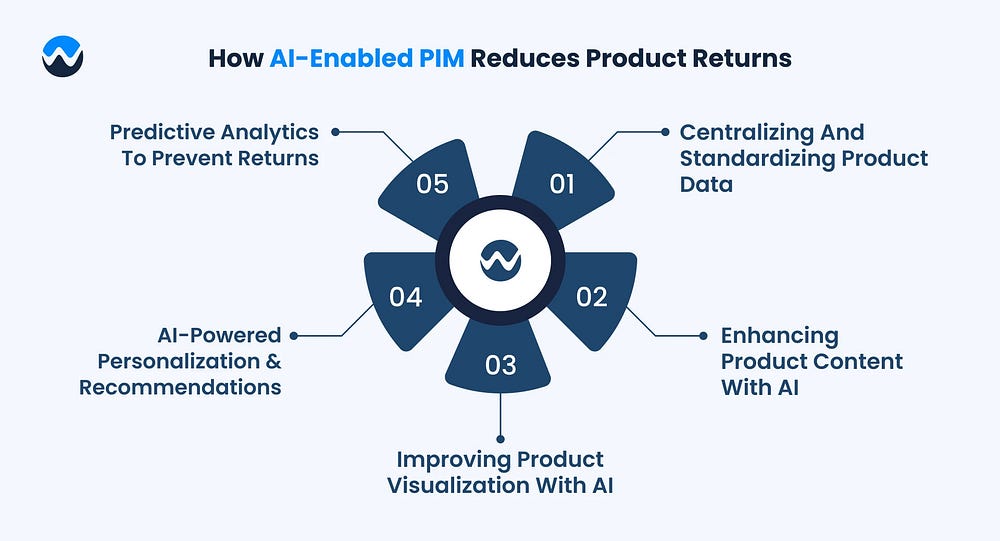
1. Centralizing and Standardizing Product Data
AI-enabled PIM creates a single source of truth for all product information across platforms. Whether it’s your website, Amazon store, or Google Shopping ads, the product details remain consistent and error-free.
Eliminates duplicate or conflicting data
Ensures compliance with multiple marketplace requirements
Reduces manual errors in product uploads
2. Enhancing Product Content with AI
AI doesn’t just store product data — it enriches it. For example:
Auto-generating accurate, SEO-friendly descriptions
Identifying missing attributes and filling them in
Suggesting optimized keywords for better product discovery
This ensures that customers always see relevant, complete, and accurate product details before making a purchase.
3. Improving Product Visualization with AI
AI-enabled PIM integrates with advanced digital asset management (DAM) tools to enhance product images and videos. AI can:
Auto-tag and categorize images for faster searches
Generate high-quality 360° product views
Ensure images meet marketplace compliance standards
The result? More realistic product representation and fewer returns due to misleading visuals.
4. AI-Powered Personalization & Recommendations
With AI, PIM systems can analyze customer behavior and preferences to deliver personalized product recommendations. This reduces the chance of customers buying the wrong product variant.
For instance, if a shopper often buys eco-friendly products, AI-enabled PIM ensures they see relevant options first — minimizing mismatch and returns.
5. Predictive Analytics to Prevent Returns
AI-enabled PIM can track patterns in return reasons and predict which products are at high risk of being returned. Retailers can then:
Fix product descriptions
Improve size charts
Add missing images or videos
Adjust recommendations accordingly
This proactive approach helps businesses prevent returns before they happen.

Real-World Impact: Reducing Product Returns with AI-Enabled PIM
Many leading online retailers in the USA are already proving the effectiveness of AI-powered PIM systems.
Fashion Retailers: By implementing AI-enabled size recommendations and enriched product descriptions, fashion brands have seen return rates drop by up to 23%.
Electronics Stores: With AI-driven compatibility checks and enhanced technical specs, online electronics retailers reduced return-related complaints by 15% in 2024.
Home & Furniture Brands: Using AI-generated 3D product views, brands like Wayfair have improved customer satisfaction and reduced returns caused by size mismatches.
These examples prove that AI-enabled PIM isn’t just a data tool — it’s a customer experience enhancer.
How Webelight’s Centralized PIM Skyrocketed Data Accuracy & Slashed Returns
Ever wonder what happens when you combine AI-enabled PIM, automated product attribute enrichment, and streamlined workflows for an e-commerce retailer? Here’s an inspiring example from Webelight Solutions — a real-world case study that illustrates the power of AI-powered product information management.
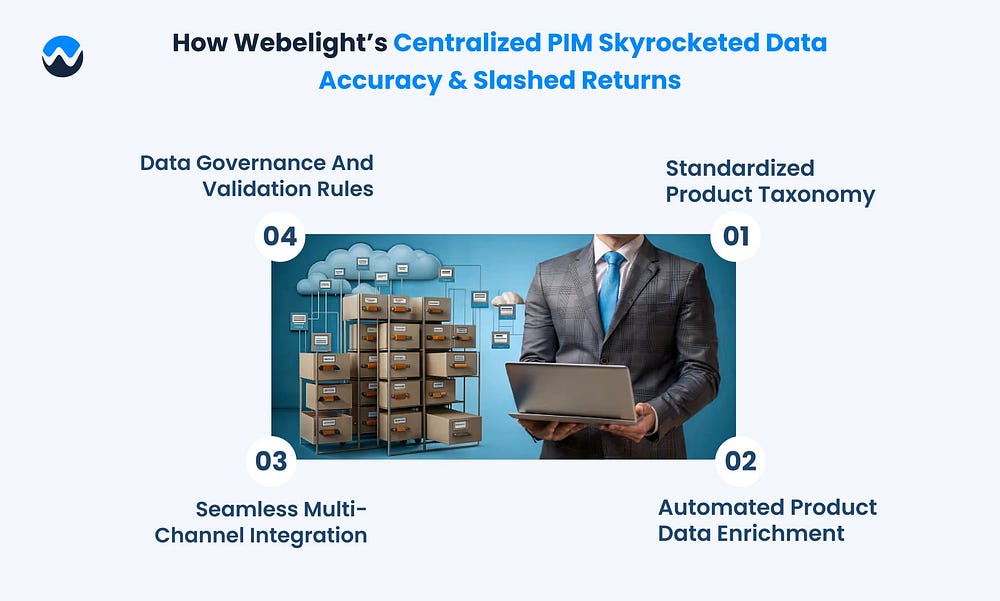
Client Challenge: A Fragmented Product Catalog
A growing U.S. e-commerce retailer was struggling with scattered data across Shopify, Amazon, eBay, and their ERP. Inconsistent product descriptions, pricing mismatches, inaccurate specifications, and manual data errors were causing:
Delays in launching new products
Customer confusion
Wasted resources and frustration
Higher product return rates
In short, their product data accuracy was suffering — and so was their bottom line.
Webelight’s Approach: Centralized, Intelligent PIM + MDM Solution
We implemented a cloud-based AI-powered PIM and Master Data Management (MDM) platform to unify all product data. What did this look like in practice?
Standardized Product Taxonomy
Created a consistent data model with required fields — like size, material, dimensions — so every SKU was defined clearly and accurately.Automated Product Data Enrichment
AI tools enhanced listings with marketing copy, comprehensive specs, and high-quality visuals, ensuring each product listing told a complete story.Seamless Multi-channel Integration
Real-time synchronization was established between the PIM platform and the e-commerce infrastructure: Shopify, ERP, Amazon, and eBay. This ensured consistent product info across all channels simultaneously.Data Governance and Validation Rules
Built-in quality checks and approval workflows made sure inaccurate or incomplete data never went live — before it could cause confusion or returns.
Impressive ROI and Business Impact
Within just over a year (13-month agile development cycle with a 5-member Webelight team), the results were compelling:
90% reduction in product data errors across platforms
50% faster product onboarding thanks to streamlined workflows
30% increase in online conversion rates, fueled by accurate and enriched catalog content
100% simplified marketplace compliance, avoiding listing errors or rejection
90% operational efficiency improvement, freeing the team to focus on strategy
40% reduction in product returns — thanks to better product data, enhanced visuals, and accurate descriptions
These results underscore how a centralized AI-enabled PIM system can dramatically improve product catalog quality, boost sales, and most importantly, reduce product returns online by ensuring customers know exactly what they’re getting
Benefits of AI-Enabled PIM in Reducing Product Returns
For online retailers, product returns are more than just a minor inconvenience — they are a profit drain and a reputation risk. According to the National Retail Federation, U.S. retailers faced $743 billion in merchandise returns in 2024, with e-commerce contributing significantly to this figure. But what’s driving this challenge? Inaccurate product data, incomplete descriptions, and mismatched customer expectations top the list. This is where AI-enabled Product Information Management (PIM) makes a game-changing difference.
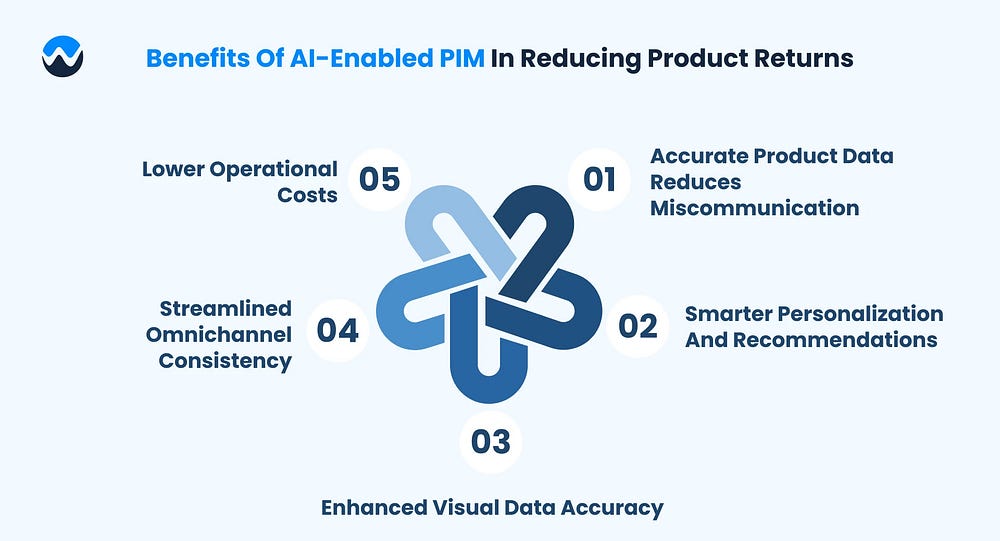
Here are the core benefits:
1. Accurate Product Data Reduces Miscommunication
With a centralized PIM system, retailers can ensure product titles, specifications, and descriptions remain consistent across all channels. AI-enabled PIM goes further by detecting anomalies and automatically flagging missing or inconsistent data. This minimizes situations where a customer receives a product that doesn’t match the description, thereby reducing avoidable returns.
2. Smarter Personalization and Recommendations
AI-enabled PIM leverages machine learning to understand customer behavior and align product details accordingly. For example, if a customer often buys products with eco-friendly features, AI can highlight sustainability attributes from the PIM database. This personalized approach reduces “buyer’s remorse” and builds long-term loyalty.
3. Enhanced Visual Data Accuracy
Images are the backbone of online shopping decisions. AI-powered PIM ensures product visuals are optimized, consistent, and correctly tagged with metadata. By reducing mismatched visuals or missing size charts, brands cut down on returns caused by “it didn’t look like the picture” frustrations.
4. Streamlined Omnichannel Consistency
Whether a customer shops on Amazon, Shopify, or a mobile app, centralized product data ensures that information is accurate everywhere. AI-enabled PIM automates this synchronization, eliminating manual errors and misaligned data that often cause confusion and returns.
5. Lower Operational Costs
Beyond reducing returns, AI in PIM reduces the internal costs of managing product catalogs. With less manual data entry, fewer compliance risks, and lower return logistics costs, businesses enjoy higher margins while improving customer trust.
How to Implement AI-Enabled PIM in E-Commerce
Switching to an AI-powered PIM solution may sound overwhelming, but with the right strategy, retailers can implement it step by step. Here’s how:
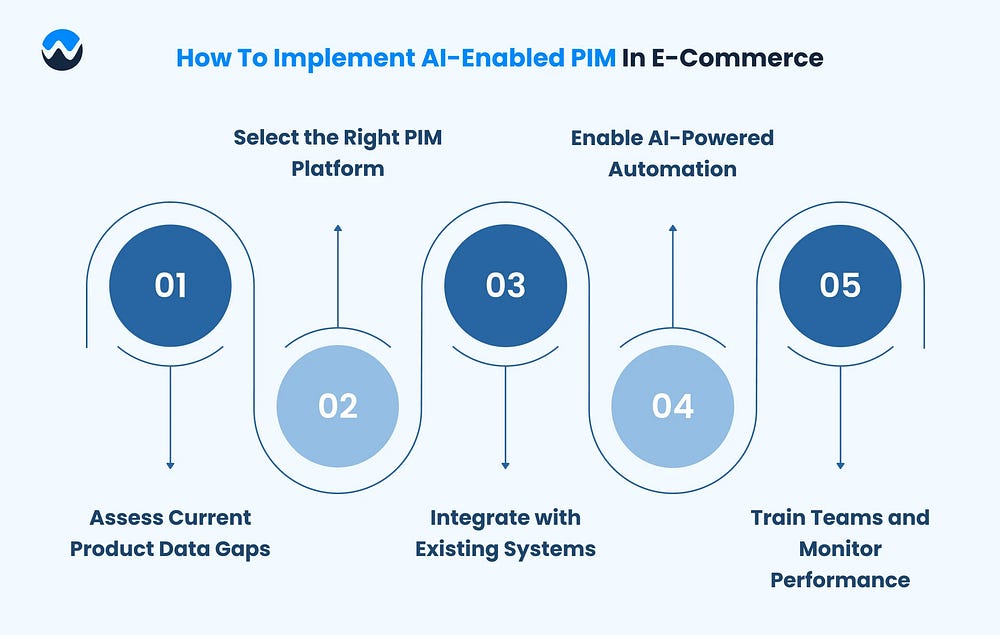
1. Assess Current Product Data Gaps
Before implementing AI-enabled PIM, businesses need to audit their existing product data. Are there missing product attributes? Inconsistent naming conventions? Outdated descriptions? This diagnostic step highlights areas where AI can add the most value.
2. Select the Right PIM Platform
Choosing the right PIM system for e-commerce is critical. Look for platforms that integrate AI features such as automated product categorization, predictive analytics for inventory, and multilingual content optimization. Retailers should also ensure the PIM can scale with their growing product catalog.
3. Integrate with Existing Systems
AI-enabled PIM works best when connected to ERP, CRM, and e-commerce platforms. This centralized product data hub allows businesses to maintain accuracy across every customer touchpoint, from digital storefronts to customer support.
4. Enable AI-Powered Automation
Retailers can set AI workflows to automatically detect incorrect data, enrich product listings with missing details, and optimize SEO metadata for better visibility. This proactive approach ensures product data stays accurate without constant manual oversight.
5. Train Teams and Monitor Performance
AI tools are only as effective as the teams using them. Training product managers, marketers, and IT teams on how to leverage AI insights is key. Businesses should also set KPIs — such as reduction in product returns, improved conversion rates, and better customer satisfaction — to measure success.
Future Trends of AI in PIM & E-Commerce
The next few years will witness a rapid evolution of AI-enabled PIM. Here are some emerging trends every online retailer should watch:
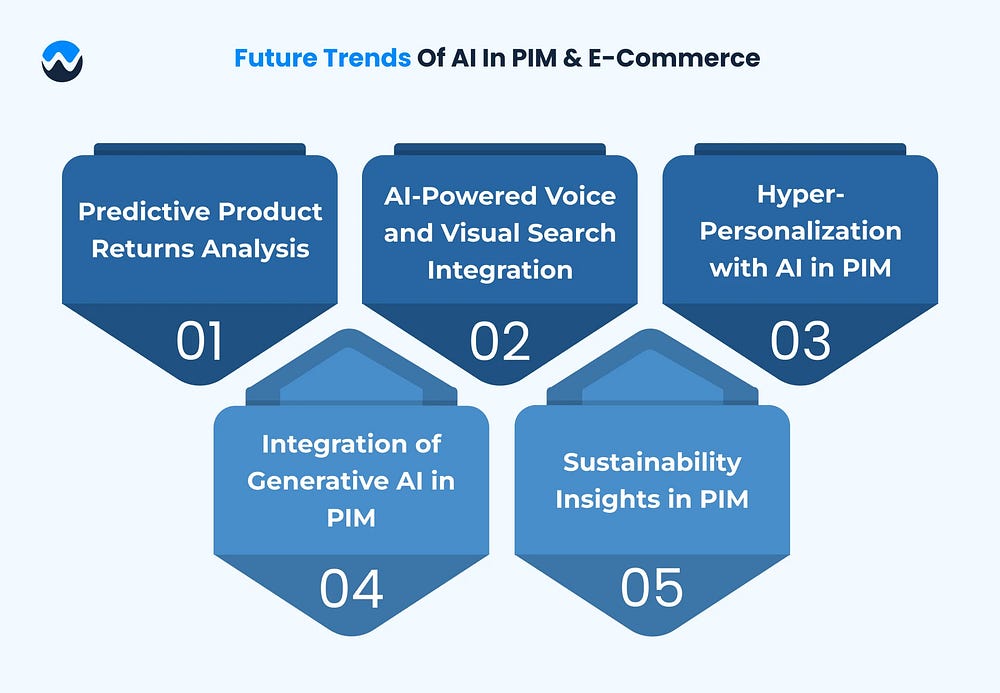
1. Predictive Product Returns Analysis
By analyzing return patterns, AI will help predict which products are most likely to be returned and why. Retailers can then optimize descriptions, visuals, or even product design to reduce future returns.
2. AI-Powered Voice and Visual Search Integration
As consumers increasingly shop through voice assistants and visual search tools, AI-enabled PIM will optimize product data for these experiences. For example, PIM systems will ensure images have the right metadata to be picked up by Google Lens searches.
3. Hyper-Personalization with AI in PIM
In 2025 and beyond, AI will drive hyper-personalized product data experiences — automatically adjusting how a product is displayed depending on the shopper’s preferences, location, and browsing history.
4. Integration of Generative AI in PIM
Generative AI will automatically create high-quality product descriptions, SEO-friendly tags, and even promotional content based on centralized product data. This reduces manual effort while ensuring fresh, engaging content at scale.
5. Sustainability Insights in PIM
Consumers are becoming more eco-conscious. AI-enabled PIM will highlight sustainability attributes — such as eco-friendly packaging, ethical sourcing, or carbon footprint — helping retailers appeal to the growing segment of environmentally aware shoppers.
Why Choose Webelight Solutions for AI-Enabled PIM
Choosing the right partner for implementing AI-powered PIM can define the success of your e-commerce journey. At Webelight Solutions, we specialize in creating customized PIM implementations that align with your business goals while reducing costly product returns.
Here’s why leading retailers trust us:
Proven Case Studies: We helped a global e-commerce brand centralize product information with AI-enabled PIM, boosting product data accuracy by 80% and significantly reducing return-related losses. Read Full Case study.
End-to-End PIM Expertise: From product data audits to AI integration, our team ensures seamless deployment tailored to your e-commerce workflows.
Scalable Solutions: Whether you’re a small retailer or a large enterprise, our AI in PIM solutions grow with your catalog and customer base.
Focus on ROI: By reducing returns, improving customer satisfaction, and lowering operational costs, we deliver measurable ROI on every project.
Future-Ready Tech: With our expertise in AI, machine learning, and omnichannel data management, we prepare your e-commerce business for the future of digital retail.
Struggling with rising product returns? Let Webelight Solutions help you implement AI-enabled PIM that reduces errors, improves customer trust, and drives higher sales. Talk to our experts today and see how we can simplify your e-commerce success.

.jpg)

Comments
Post a Comment